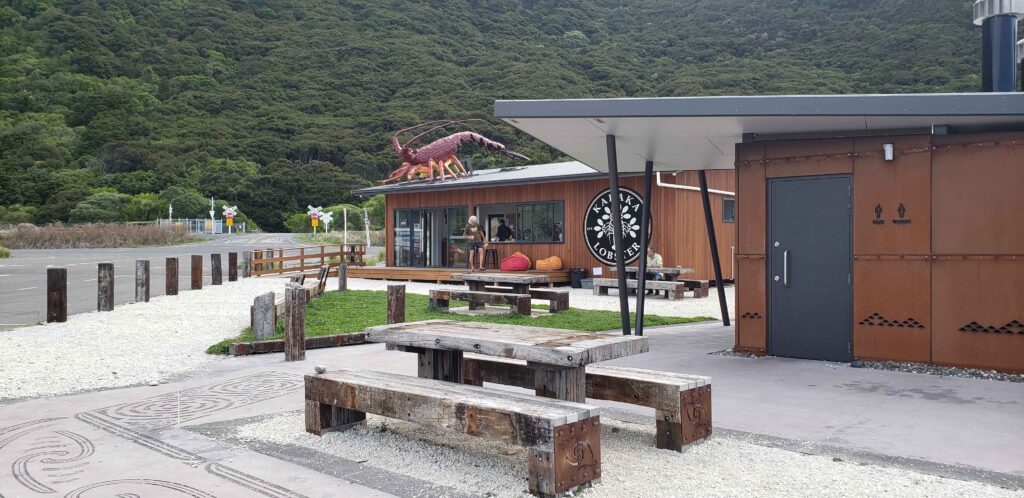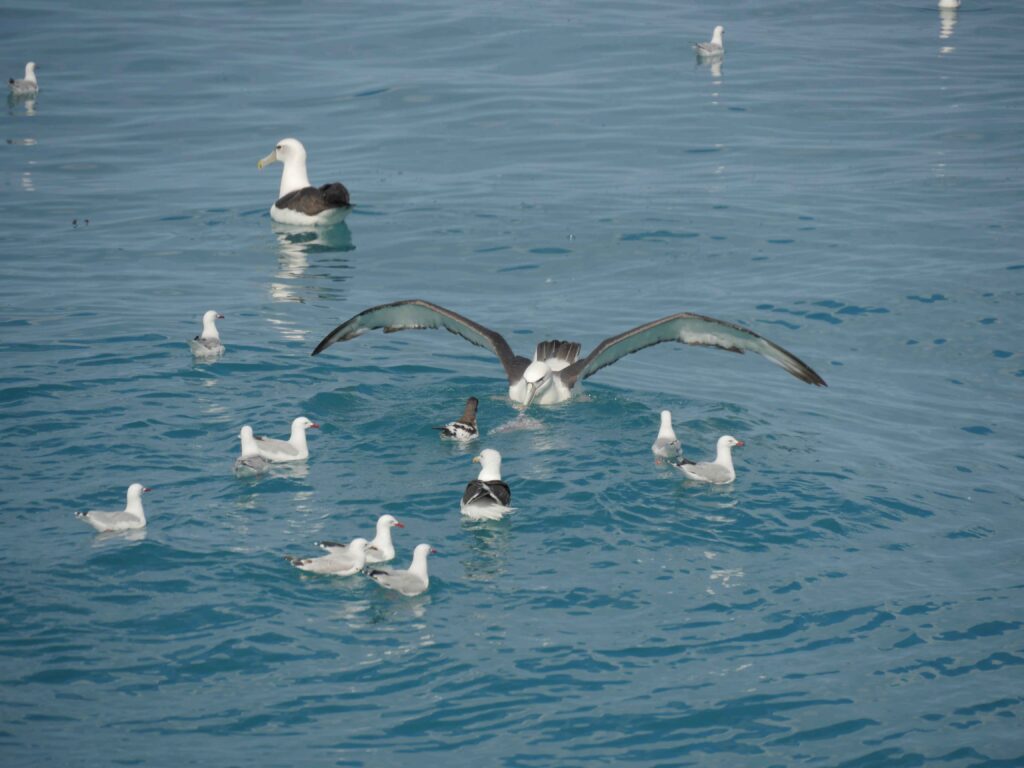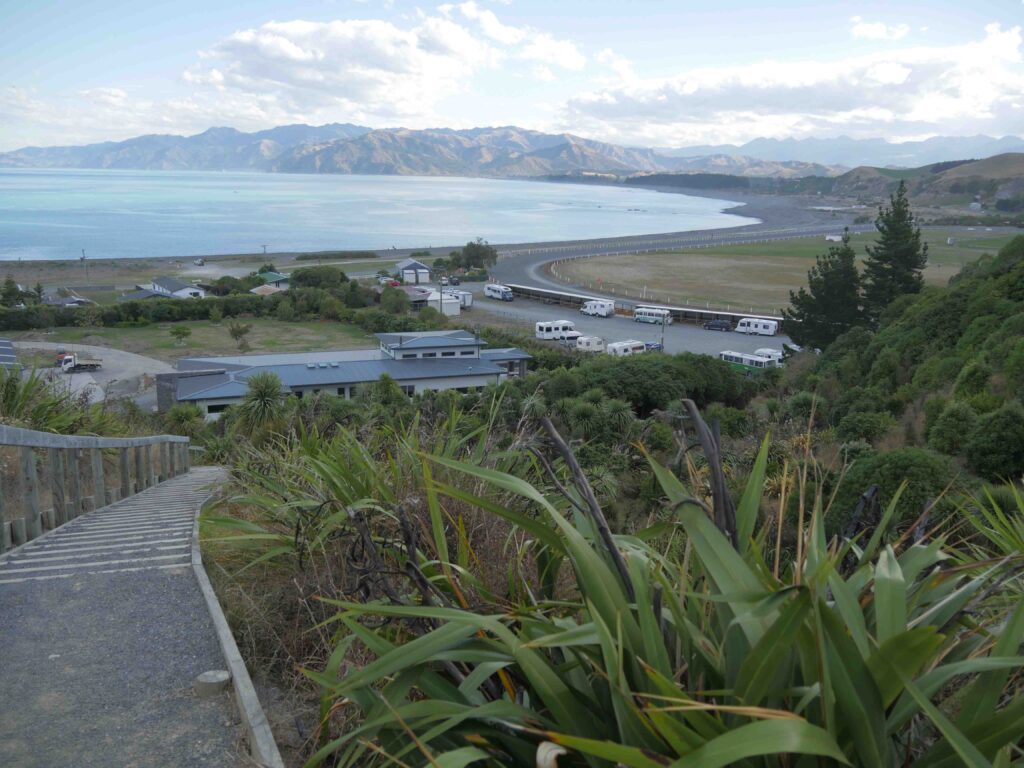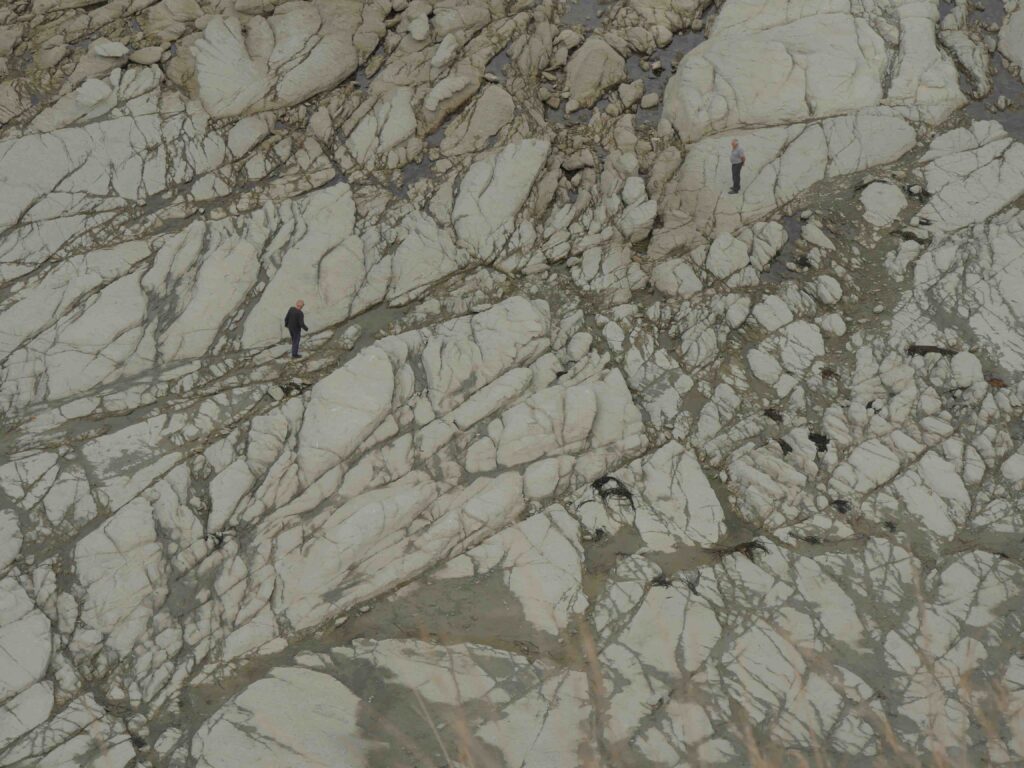Kaikoura – 11/04/21 To 14/04/21
2 Comments / Canterbury, South Island / By George
The drive from Marfells Beach to Kaikoura was fascinating with significant geological remnants, scars and reconstructed areas of the 2016 earthquake visible on both sides of the road along the coast. This earthquake caused ruptures on more than twenty fault-lines, a world record number in fact. Uplift of the coastline was significant with as much as six metres of vertical movement recorded in one area. There were some photos on the wall inside the café of the rockfalls that occurred as a result of the earthquake in the near vicinity to where the café now stands. I wasn’t aware until talking with locals that there were actually at least six major slips on the State Highway as a result of the quake.
Our first stop after leaving Marfells was at the ‘Karaka Lobster’, obvious by the large crayfish on the roof. It was a relatively newly constructed (2019) café selling fresh crayfish and other seafood delicacies. Debbie just wanted a coffee despite the treats on offer. This establishment and the adjacent parking area were well populated with visitors, as it took in good views of the Pacific Ocean and the coastline, offered excellent dining and there were public toilets adjacent to the café. We reclined in bean bags on the deck out the front of the café while Debbie savoured her coffee, before moving on to Ohau Point.

Ohau Point was the location of a major rockfall involving 160,000 cubic metres of material that blocked both State Highway 1 and the main-trunk railway line in the earthquake. As a result of what can only be described as a miraculous feat of engineering, construction and earthworks unprecedented in NZ, the road was reopened thirteen months later, with restricted freight able to use the rebuilt railway line only 10 months after the quake. In the end 200 kms of road and 190 kms of rail had to be reconstructed, along with some works still continuing to this day.

Also at Ohau Point is a fur seal colony, with a number basking in the sun on the rocks below the viewing promenade and others cavorting in the rock pools, during our visit there. It’s great to see the colony not only re-established after the quake, but actually thriving in the environment. There was a walk to the Ohau Stream waterfall on the inland side of the road about 1 km north of Ohau Point, where the fur seal pups would travel up the river and frolic in the waters under the falls. However due to the earthquake this walk is currently closed. A neighbour of ours from Auckland had spent much of his life on contract to Kiwi Rail in the two years following the quake in this area, clearly along with many other extremely committed and skilled workers. Kiwi Rail deservedly won a North American award for the works involved in this massive reinstatement, the first time ever it had been won by anyone outside the USA. This scene of earthquake disasters and reconstruction would play out many times in different forms over the next few weeks.
We moved on to Kaikoura township, where we would stay for three nights in total, two of those at the southern NZMCA park and one at the northern NZMCA park. The southern park is on South Bay Road and is part of the Kaikoura Trotting Club racecourse and is not available on race days or show weekends. However neither of those were in effect and we joined our friends Rod and Jill, who by chance were in Kaikoura for a couple of days before heading north. It was great to see some familiar faces from the northern ‘homeland’ and discuss their travels in the south where we were headed. The park itself was pretty basic with no facilities or dump station, but it was only a walk across the road to look out on South Bay, where dolphin sightings from the beach were common. Apparently there were some while we were there but we needed to be up earlier!

Day Two in Kaikoura and we were off with Rod and Jill on a ‘whale watching cruise with ‘Whale Watch Kaikoura’. We had booked this some time ago, but although they booked at short notice there were still spaces available. This was a sign of the times. Although the cruise host thanked all the New Zealanders for being on board and supporting their local tourist industry and that the number of NZer’s had doubled since Covid had decimated international travel, they were only running at 30% of pre Covid capacity. This was symptomatic of many of the campsites, tourist destinations and adventures we attended on our travels. It was a traveller’s dream for us as there were no queues, no jostling with foreign tourists on ill-planned heavily time constrained itineraries and even a diminishing number of locals, as the South Island ‘retiree run’ of February and March was starting to wane.
The weather for the cruise was ideal, with clear skies and only light breeze. Although the actual cruise left from South Bay we had to go into the township proper to undertake the check-in formalities and then be taken by bus back to South Bay for boarding. We got a lift into town from Rod and Jill in the hope that the return bus would just drop us back at the camp after the cruise (which it did, after minor negotiation). There was about a 1.5 m swell running out in the bay in places, but no real waves and the temperature was balmy. Given the only other time I had seen a whale in the ocean was off the beach in Rarotonga, I wasn’t overly confident, but the crew certainly were. This is one of the few areas in the world where whales are incumbent all year round and we weren’t to be disappointed. The Whale Watch blurb explains that “Kaikōura is one of the few places in the world where Sperm Whales can be seen year-round and close to shore. They congregate here because the 3km deep Kaikōura Canyon runs right up against the coast creating a rare system of sea currents that sustain an incredibly rich marine food chain. Sperm Whales are at the top of this food chain and the abundance of fish ensures they make the waters of Kaikōura their home”. Which is why the tour companies can offer a partial refund of your cruise fee if no whales are seen – their success rate is very high.

We had probably only motored for about 20 mins before two humpback whales came into sight and an accompanying pod of around one hundred Dusky dolphins. It was up on deck with cameras and phones clicking frantically in the hope that one of those whales just might do the iconic ‘mighty leap’ out of the water. It wasn’t to be though and in fact that is quite a rare sight so we were told. The best we could achieve is that hump on their back and the rise and fall of the tail as they dived. Still the dolphins made up for it and it was astonishing to see the level of self- indulgent fun they have in this huge playground, twisting and turning in the air and completing full somersaults, racing through the water alone or in groups beneath the boat with that effervescent dolphin grin on their faces. Sure maybe all that is not just mere folly, but rather part of the process of herding prey, but it sure seems more of an enjoyable existence than being a sheep and chewing grass all day.

Not far from the whale/dolphin experience a couple of albatross had nestled in the water with one chewing feverishly on some form of sea creature. A flotilla of gulls gathered around them no doubt awaiting the crumbs from the plate, but not confident enough to take the albatross on for the spoils directly.

We next motored over to a small island near the coastline where a seal colony was located, before heading across the bay further to where the Hector’s dolphins can be found. They are endemic to the NZ coastline and I felt we were fortunate to see three of these cruising the waters here. Photographing them was challenging as they are not nearly as brazen or acrobatic as the Dusky dolphins, but Debbie did a pretty good job whilst jostling with others.

We really enjoyed the cruise, which was lucrative in terms of the promised nature spotting opportunities on offer off the coast of Kaikoura. There was a video information presentation while we were travelling covering off the statistics and lifestyle details of the creatures we might see, together with commentary at appropriate times of what we were watching live. The cruise lasted about 2.5 hours and you had to take your own drink and nibbles if you needed anything over this time span. There was a good discount offered for NZMCA members on the price of this cruise so always check for that when booking.
After a simple lunch we headed over the hill from the camp at South Bay to the township via a walking trail, which eventually brought us down to the Esplanade. A walk along here toward the town centre gave us a view of the coastline and Pacific Ocean from the northern side of the Peninsula. The township was modestly populated with a mixture of locals and visitors judging from the number of motorhomes parked and passing through town. I noted there was a bicycle shop in town, which was useful as I needed a new tyre and tube – we would deal with that the following day successfully. We took the long walk back from town onto SH 1 and then onto South Bay Parade around the back of the Trotting club track to the camp.

Taking the advice of our neighbour, whom I mentioned above had spent considerable time in Kaikoura, we headed for ‘The Pier Hotel’ restaurant for dinner. Debbie could not resist the crayfish, being the local delicacy, but even though I like seafood I think crayfish is over-rated, although not as over-rated as caviar! After a spate of motorhome meals anything is a treat and I opted for the lamb shank. A fine meal it was too. You will note in these blogs that I never mention wine or beer and there are numerous fine vineyards and craft breweries that we would encounter on route, many of which are highly recommended. Debbie does love a good Sauvignon Blanc but I’m completely ‘nil-alcoholis’ (Latin for ‘everything tastes like vinegar to me’). If you’re looking for great wine and beer recommendations you’re on the wrong blog.

After dropping my bike off for the tyre repair we hung around town killing time until the repairs were completed. We made our statutory pilgrimage to the local art gallery come craft centre and was once again amazed at the diversified artistic talent in the local and surrounding community. We rarely if ever purchase anything, but Debbie in particular draws great inspiration from these visits in one form or another. Often a new creative direction will be born in these places.
It took longer than expected but the bike shop finally gave us the nod that the bike was ready. We loaded it on board and headed off to the northern NZMCA park. The facilities here were vastly better than the South Bay park, with a dump station, water, waste disposal and even a large lounge area with active jigsaw puzzles, should you be at a loose end. The guests we ran across in the lounge suggested we might return later for pre dinner BYO liquid refreshment, apparently a regular event here. Until then we took a 20 km return bike ride up Beach Rd and Lovers Lane to the State Highway. This was all public sealed road, not a bike trail and narrow enough to be concerned about motor vehicles, but it was sparingly used and visibility of traffic was good. There were glimpses of the ocean, although we needed to pull off the track to reach the beach itself, which consisted of dark sand littered with river stones. The sand was no where near compacted enough for cycling. We returned to the camp slightly after wine o’clock was due to commence only to find no one in sight, apart from one or two others wandering around mumbling about the non event. This was to be our last night in Kaikoura as we had to move on to meet our Christchurch deadline.

However, before we left we wanted to visit the Peninsula headland and do at least some of the walkway that traverses the cliff edge right around to South Bay. When we arrived there the tide was out so we were able to walk a considerable distance out on the rocks. These had been upthrown in the 2016 earthquake, the most recent tectonic event in the area, which has a long history of such events. The platforms that are seen along the peninsula have been raised then wave cut over a lengthy geological history. The rocks are a mixture of mudstone and heavily folded limestone formations. Sea life is returning to the area after the last quake and a seal colony exists on the rocks below the headland cliffs. While we there a number of seals could be seen sleeping on the rocks. Heed the signs regarding the seals, keep your distance and be aware that seals can venture far from the rocks into the vegetation, like the one we saw resting on the boardwalk beside the road. Sometimes you can smell them before you sight them.

basking on the mudstone rocks

The walk up to the top of the peninsula headland plateau was definitely worthwhile. The climb at the start on a paved walkway was a little steep, but not too long. We ventured beyond the first bay only on the track through the grassy fields and both the walk atop the headland and the foray out onto the rocks at sea level were very popular during our visit. There are toilets adjacent to the carpark but overnight camping for motorhomes is not allowed here.




A caravanner at the camp strongly suggested we take the inland route south and stay at the camping ground at Waiau, as it’s a very scenic route. It was finally time to move on from Kaikoura and the inland route drive to Waiau late on a relatively sunny afternoon was beautiful, since in many areas the colours of autumn were still vibrant. This was good advice as it turned out.
